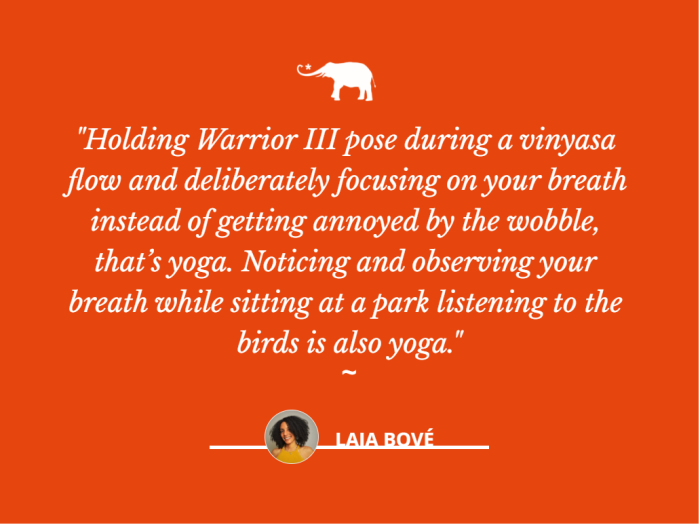View this post on Instagram
Like many other stories you may have read, I, too, came to yoga through the movement and vinyasa route, fully focusing on the physical practice.
I was a professional athlete, and I enjoyed taking yoga classes here and there because I was “good” at it and it felt empowering.
Read here that I could basically touch my toes and sometimes attempt contortionists shapes just because I have long limbs, and well, I was a figure skater.
It took a few years, a Crohn’s disease diagnosis, and my first yoga teacher training to begin to grasp the concept that what I thought to be yoga wasn’t even the tip of the iceberg. I was shaken, ya’ll.
If you’ve never tried yoga because you wouldn’t fit in, here is the great news: having a flexible and pliable body is not a requirement. Being in shape is not necessary. The practice is still for you if you’re disabled or ill, regardless of your gender or your identity, no matter the size and shape of your body.
Yoga can be quite accessible, yet many teachers, studios, and even yoga teacher training programs still choose what looks good, what sells, the “we’ve always done it this way” route over accessibility and inclusivity because it’s just easier.
Yoga asana, the physical practice in the way that is mostly seen and practiced in the West, can be performative and inaccessible and has a tendency to remain on the surface, only focusing on a small part of what yoga can really bring into your life.
Moving your body is, of course, important and I highly recommend it, yet knowing that to incorporate yoga into your life, you don’t actually have to make particular shapes with your body makes it accessible for many more.
1. Change the the focus to the breath
Unlike movement, breathing is essential to your existence. Without the breath, there is no life.
Holding Warrior III pose during a vinyasa flow and deliberately focusing on your breath instead of getting annoyed by the wobble, that’s yoga. Noticing and observing your breath while sitting at a park listening to the birds is also yoga.
There are many breath (pranayama) techniques that you can explore with a qualified teacher who will help you increase your capability to self-regulate your nervous system, and with practice, you’ll be able to use these tools when you need them most.
The more you practice breathing in a way that grounds you and brings you to the present moment in a relaxed yet focused way, the more able you’ll be to connect to that same breath, and eventually feel during a difficult conversation, while stuck in Friday traffic, or even when scrolling through your feed.
I am way more impressed by someone who can regulate themselves through breath and awareness than by a “yogi” doing crow to chaturanga jumpbacks, but maybe that’s just me.
Asana without breath is gymnastics.
2. Mad props
I personally use props in my practice every day. My favourite ones are blocks, but this girl won’t say no to a blanket, a bolster, or a strap either.
Nowadays, yoga teachers who consciously choose to teach asana without offering props and options are being ableist. It’s as simple as that. Offering a one-pose-fits-all approach in a class doesn’t cut it anymore, no matter how creative your sequencing is.
Most of the time, students do not learn to use props because the instructor hasn’t taught them how to; they only present them as “I guess if you can’t touch the floor with your hand, you could use a block.” Well, thanks Nancy for creating hierarchy and inequity in a class.
To me, it reverts back to the breath and being present: if using a block under your bum in garland pose will allow more space for your hips and for your breath, why wouldn’t you? If keeping your back knee down in a lunge will give you better stability than lifting it up, why would that not be suggested?
Offering or not offering variations and props can mean the difference between a student being able to take a class and feel welcomed, or feel excluded and never going back to yoga.
Folks with limb differences, disabilities, larger bodies, or living with chronic pain and illnesses (and any human, really) can truly benefit from a teacher who is not only trauma-informed, but accessibility-driven, and who will choose to demonstrate postures with props and offer variations instead of focusing on looking like they’re the baddest and coolest contortionist and athlete in the room.
Choose your teachers wisely, friends. We’re not there to perform; we’re there to serve you.
3. Bend so you don’t break (figuratively)
Recognise that every day that you choose to get on your mat, you will feel how you feel, hence the practice you need each day may be different.
Mindfully observe your life and your practice and how they reflect and mirror one another. Pay attention: what is your level of energy? How busy of a day have you had or is ahead of you? How much sleep did you get last night?
Make a choice from a place of self-love that supports you.
Hint: power yoga is not always the answer.
You may feel incredible now, yet injuries happen, illnesses happen, pain happens. Your practice can be the thread that keeps you balanced and that supports you through it all if you learn to be adaptable and listen to what you need instead of what your brain wants. Pushing yourself past the breaking point is most likely not what truly serves you. I speak from experience.
If you establish a good combination of physical practice, breath, and meditation, you’ll learn that you are doing yoga all the time, and the pressure to keep it up, regardless of your physical or mental health, will dim.
So pay attention, learn to trust your breath, your body, your intuition. Practice with teachers and in spaces where a supportive and inclusive environment are not only in the mission statement but are embodied in every class.
Use all the props, take all the breaks, stay for savasana.
The magic of yoga is not in the postures, but in the awareness and the space it creates for us all: body, mind, and spirit.
Let’s make space for everyone.


 Share on bsky
Share on bsky





Read 5 comments and reply